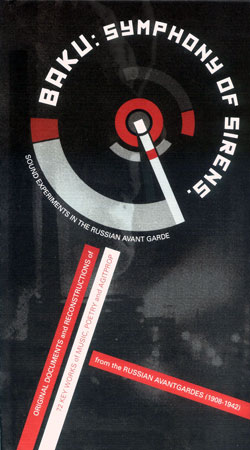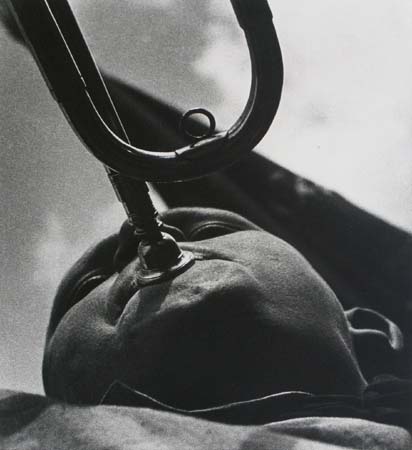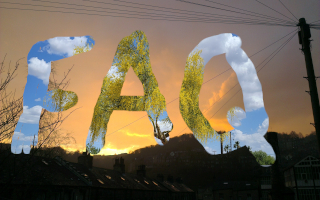
Baku: Symphony of Sirens. Sound Experiments in the Soviet Avant-Garde:
Original Documents and Reconstructions of 72 Key Works of Music, Poetry and Agitprop from the Russian Avant-Garde (1910-1942) (Hardcover)
2*CD + 72 pp booklet
Recommended Records ReR RAG1
 Why do so many musicians strain to attach themselves to the assault units of modernist art? Maybe some cachet can be had simply by aligning yourself publicly with these 'icons of iconoclasm' (now that they're dead and can be taken as a thrilling tonic or pick-me-up), or do the musicians concerned really try somehow to extend the same traditions?
Why do so many musicians strain to attach themselves to the assault units of modernist art? Maybe some cachet can be had simply by aligning yourself publicly with these 'icons of iconoclasm' (now that they're dead and can be taken as a thrilling tonic or pick-me-up), or do the musicians concerned really try somehow to extend the same traditions?
From Cabaret Voltaire (named for the original Zurich Dada club that kept Lenin awake at night) to Merzbau (the name lifted from Kurt Schwitters' art-spaces) and even the lame ZTT Records (from Marinetti's poem 'Zang Tumb Tumb') musicians have chosen to salute the heroes of the avant-garde. Nurse With Wound launched themselves with an album that took its title from proto-Surrealist Comte de Lautréamont's description of a young boy as being "as beautiful as the chance meeting on a dissecting table of a sewing-machine and an umbrella", though the music is closer to Art Brut than Surrealism. Since then they have repeatedly raided the images and ideas of the avant-garde to label and illustrate their work. Many of their fans, on the other hand, see no irony at all in talking of them as a 'serious' Art (capital 'A') band for sophisticates such as themselves, thus projecting onto the group the same dull-witted, quasi-religious aura that the Dadaists hoped to snuff out forever. Have they never heard of Picabia's claim that "Art is a pharmaceutical product for imbeciles"? When musicians align themselves with the modernists perhaps they are not as cutting-edge as they suppose, since even academies and art galleries can now safely dabble with high-modernist art now that its social content has been repressed: they tack the corpses to the wall. The Museum of Modern Art is nothing more or less than a modern temple. So, are we dealing with the content of the art or just juggling with fancy labels?
To navigate your way through this puzzle requires seeing the modernists in context, treating them not as technical innovators with 'interesting personalities' but as people who wanted to change the way we live - not merely adjusting the colour balance of your senses but upturning the relationships art is bound up in. The modern movement of the late 19th/early 20th century was framed by three great social facts - the collapse of the old world (empire and ancien régime), the accelerating pace of technical change and, crucially, the sense that everything was about to change forever, for the better (the immanence of social revolution). Nothing expresses this conjuncture better than the co-mingling and interpenetration of the political and artistic avant-gardes during the insurrectionary phase of the the Russian Revolution (the years leading up to the October 1917 uprising through to the point at which Stalin drowned the revolution in blood some ten years later.) The lightning shock of revolution turned the tinder of pre-revolutionary modernist experimentation into the flame of revolutionary art, focussed not at changing the 'How?' of artistic representation (formal innovation), but responding to the question 'Why?!' (art and its relation to life.)
It's appropriate that Chris Cutler's Recommended Records should be behind the release of these reconstructions and original documents relating to the period, as the members of Henry Cow were always at pains to make connections between art and wider issues of politics. The theme here is the Russian avant-garde considered in the widest sense - in politics, in music and the arts, and in social life - with (quite rightly) no attempt to shove each member back into its specialised compartment.
There are two halves to this release, each with its own CD. The first consists of reconstructions of some of the most notorious works of Russian avant-art, meticulously reconstructed by Miguel Molina and Leopoldo Amigo from original scores and other relevant documents for Valencia's Faculty of Fine Arts (see what I mean?), the works are expanded upon here. The centrepiece is their reconstruction of Arseny Avraamov's astonishing 1922 'Symphony of Sirens', in which the entire city of Baku - its people, alarms, factory sirens, locomotives, two artillery batteries, infantry regiments and the foghorns of the local fleet - is used for the performance of his great work of proletkult art, and the city itself is made to sing. There's no escaping the fact that listening to this most careful of recapitulations can never substitute for the experience of the symphony itself as originally performed, which we can only imagine: the Faculty of Fine Arts simply can't replace the streets of Baku. So, here too we are inevitably dealing with a corpse (the Baku City Council presumably being less amenable these days to such performances). But there's enough of a trace here for the listener to sense something of the event. Along with Avraamov's symphony there are reconstructions of works by Prokofiev, El Lissitsky ('About Two Squares
- A Suprematist's Story'), Stepanova, David Burlik, Khlebnikov, Kasimir Malevich and similar iconoclasts and dreamers, including representatives of such exotic futurist-constructivist groupings as The Ego Futurist Group, H2SO4, the Nothingists and the Psycho-Futurists.
 (image by Alexander Rodchenko)
(image by Alexander Rodchenko)
Disc Two carries original recordings from a similar array of wayward talents (which, in the context of this box, is a perfectly good way to describe the likes of Vladimir Ulyanov and Lev Bronstein... 'Lenin' and 'Trotsky' to you.) Transfers from ageing wax and shellac mean that the sound quality sometimes evokes the bleeding edge of politico-cultural insurrection only through the gauze filter of hiss and crackle, with the result that the urgent futurism of the original performances is accompanied by a nagging awareness that you are listening in to a bygone age and observing a lost world (fittingly, the bonus disc for subscribers consists of a version of Vasilisk Gnedov's 'Poem of the End'
- originally a work in which the announcement of the title is followed a few minutes by complete silence, long before John Cage got in on the act - but here the silence is replaced with the sound of a wax cylinder turning.) All the same there are recordings that still have the power to thrill (Dziga Vertov's 'The Dombass Symphony' and Mossolov's 1928 'Symphony of Machines - Steel Foundry' in particular), as well as speeches from the Bolsheviks (Lenin and Trotsky, already mentioned, and Worker's Oppositionist and 'feminist', Alexandra Kollontai), radio art, sound poetry from Lili Brik and - the original 'cloud in trousers' - Mayakovsky, as well as (relatively) traditional fare from Akhmatova, Ilya Ehrenburg, Sergei Esennin ('Confessions of a Hooligan'), Pasternak and more.
There's too much work here, on too broad a scale, to neatly summarise. And anyway the point of the release isn't to encapsulate but to allow a peak into an extraordinary ferment of experimentation and debate, from the most radical constructivism through to the neo-classicism of, eg., Osip Mandelstam. The various works here, from different parts of life, and different political and artistic philosophies, are allowed to jostle one another, pregnant with potential resolutions and conflicts, just as they did in real life. The accompanying notes provide brief information on each of the works and contributors - enough to set the tone and to intrigue but not trying to tie everything together, which is as it should be. The questions raised by the long-dead contributors (many of them murdered by the Stalinist regime as it placed its stranglehold on art along with the rest of society: 'suffering for your art' took on a whole new meaning under Stalin) remain unresolved. Even if you believe that the idea of the avant-garde is itself now anachronistic there's no doubting that the underlying question of how how art might bear upon and mix with an expanded sense of living remains relevant. If nothing else it is worth being reminded that today's sonic 'radicals' have ancestors who, many years before, set a kind of high watermark of cultural ambition against which everything since should be measured.
Andy Wilson
 Why do so many musicians strain to attach themselves to the assault units of modernist art? Maybe some cachet can be had simply by aligning yourself publicly with these 'icons of iconoclasm' (now that they're dead and can be taken as a thrilling tonic or pick-me-up), or do the musicians concerned really try somehow to extend the same traditions?
Why do so many musicians strain to attach themselves to the assault units of modernist art? Maybe some cachet can be had simply by aligning yourself publicly with these 'icons of iconoclasm' (now that they're dead and can be taken as a thrilling tonic or pick-me-up), or do the musicians concerned really try somehow to extend the same traditions? 
 (image by Alexander Rodchenko)
(image by Alexander Rodchenko)




